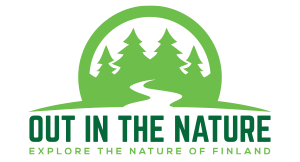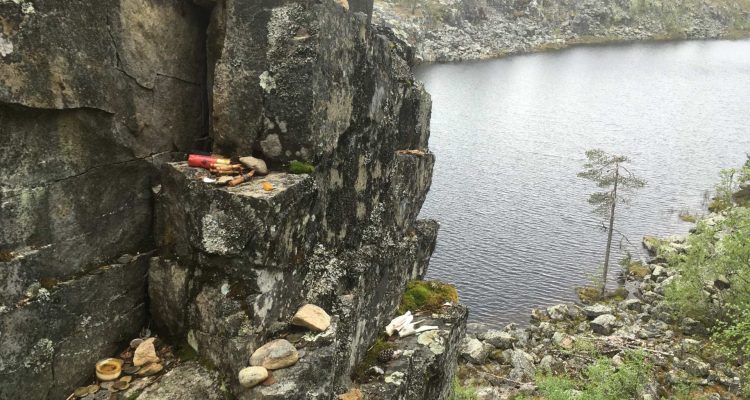Are you interested in unlocking the secrets of Finnish mythology, where sacred sites are revealed? Explore how the profound reverence of ancient Finns for gods in nature illuminates the enduring relationship that modern-day Finns maintain with their environment. Finland has long been a haven for nature enthusiasts. But beyond the breathtaking scenery lies a rich Finnish mythology that weaves the ancient beliefs of the Finns with the very fabric of the natural world. In this article, we delve into the world of Finnish mythology and explore many sacret sites in Finland.
It all begins with Kalevala
At the heart of Finnish mythology is the Kalevala, a collection of epic poems that encapsulate the beliefs and stories of ancient Finns. Composed by Elias Lönnrot in the 19th century, it weaves together a collection of oral traditions and folk poetry into an epic narrative. Kalevala is a symbol of Finnish national identity and such a significant cultural and literary work in Finland that it is often studied at school in the context of Finnish cultural history.
The Kalevala is also a testament to the deep connection between the Finns and the natural elements. Its connection to nature is profound and integral to themes, characters, and overall narrative. A significant portion of the Kalevala’s stories takes place in the vast forests and wilderness of Finland. The characters embark on journeys through dense woodlands and explore the rough seas on a boat. Finnish mythology, as portrayed in the Kalevala, is characterized by animism — the belief that natural entities such as trees, rocks, and bodies of water possess spirits or deities.
Finnish gods of nature
In Finnish mythology, a pantheon of gods and spirits inhabited the forests, lakes, and skies, embodying the essence of nature itself. Tapio, the god of the forest, was revered for his role in overseeing the vitality of the woodlands. Ahti, the god of the sea, commanded the waves and creatures beneath the surface. These deities were not distant figures but integral forces believed to influence the very ecosystems that sustained the Finnish people.
Read more about gods of nature:
Traditional Finnish deities are all linked to nature
Which traditional Finnish deity are you?
Explore these sacred sites and mythical nature destinations in Finland
The ancient Finns considered certain natural sites as sacred, believing them to be dwelling places of powerful spirits. These sacred groves, rocks, and bodies of water were often sites of rituals and ceremonies aimed at appeasing the gods and ensuring the fertility of the land. Modern Finns, though not bound by the same religious practices, continue to hold these natural locations in high regard, fostering a deep respect for the environment.
Sacret seida rocks are stunning rock formations
Seida, or seita in Finnish, is a term used in Sámi culture to refer to sacred stones or sites associated with spiritual significance. These sites are often considered to have a connection to the spiritual world. Most seida rocks are noticeable landmarks and clearly stand out in their environment.
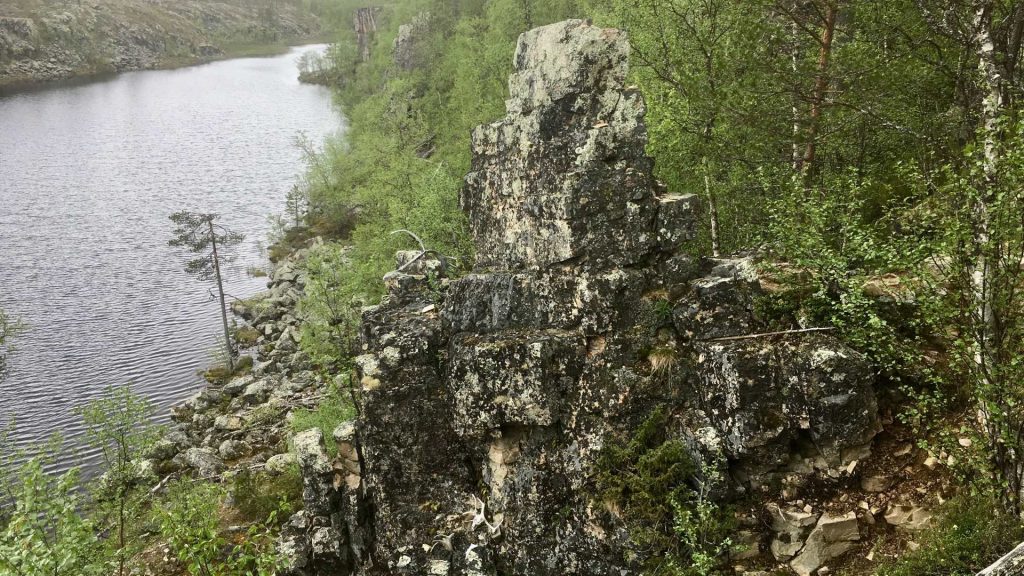

Sami sacret site Taatsi seida
Taatsi seida, or Taatsin seita in Finnish, by Taatsi lake is an ancient Sámi culture site where the local Sámi people brought offerings to the gods. It is located in rural Pokka village between Kittilä and Inari. Near the Taatsi seida you can find Taatsi church, Taatsinkirkko, which is a rock wall with a church-like echo if you sing by it. The rock formation was thought to have been made by giants due to its unusual and peculiar shape.
Astonishing Äkässaivo on Saivonkierros nature trail in Muonio
Another famous seida rock in Lapland is Seitapahta in Muonio. Äkässaivo lake and the impressive seida rock Seitapahta in Muonio can be visited by 3 kilometers long circle trail called Saivonkierros. It is easier to reach than Taatsi seida from Muonio or Kittilä, but equally spectacular.
Näkkälä’s Seita is a famous old sacred site in Enontekiö
Näkkälä’s Seita in Enontekiö has been used as sacrificial site by both fishermen and reindeer herders. While this seida may not boast the same level of spectacle as the more renowned Taatsi or Seitapahta, I can swear to its efficacy as a sacrificial altar. Read more about my luck with foraging and fishing from the full story.
Pakasaivo, the Hell of Lapland
Lake Pakasaivo located in Muonio, Lapland, is also known as the Hell of Lapland. Why, you may wonder. Let us reveal to you the secret of saivo lakes in Finland: In ancient times, there was a belief that saivo lakes possessed dual bottoms, and occasionally, fish would vanish into the depths below. This belief was rooted in the idea that on the opposite side of the lake’s floor existed another world where souls found their abode. Kirkkopahta seida rock is located close to Pakasaivo and can easily be visited at the same time.
Fascinating devil’s churns can be found all around the country
The devil’s churns, hiidenkirnut in Finnish, are also known as giant’s cauldrons, giant’s kettles, or potholes. They were formed about 10 000 years ago at the end of ice age when meltwaters eroded the rocks. Devil’s churns are deeply connected to the Finnish mythology and have some amazing tales to tell. Here are some of the devil’s churns we have explored in Finland:
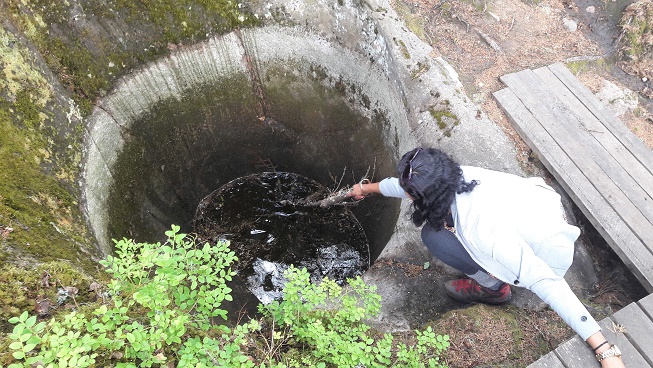

Askola giant’s kettle park
The most known devil’s churn destination is Finland is the Askola giant’s kettle park that has 20 kettles. That is the most kettles in one place in Finland. Askola is located about 3 hours away from Helsinki in the direction of Porvoo and Mäntsälä.
Sukulanrakka devil’s churns in Rovaniemi, Lapland
Accessible only during summer months, Sukulanrakka hides 14 giant’s kettles, some of them among the largest ones in Finland. According to Finnish folklore, a devil used to live in Sukulanrakka. One time the devil heard that a Swedish bishop was coming to convert locals from their pagan ways. What followed was an epic battle that left its marks in the nature.
The seven giant’s kettles of Sorlampi
Sorlampi in Nuuksio national park in Espoo is popular nature destination in capital area. At Sorlampi you can find seven giant’s kettles nicely grouped together.
Talvia’s giant’s kettles in Lohja
These few devil’s churns in Lohja are not the most impressive ones but they are pretty easy to reach and worth visiting if you happen to be in Lohja or near the capital area. One small but deep gian’ts kettle can be found from Pääkslahti nature trail in Vihti, also close to the capital area.
Mythical landscapes devil’s fields are ancient beaches
The devil’s field, pirunpelto in Finnish, earned its name due to the belief that the devil created these boulder fields. In Finnish mythology, the devil (piru in Finnish) was seen as the antithesis of God, cultivating crops in rocky fields in opposition or angrily hurling rocks onto the land. Devil’s fields have been created during the Ice Age when glaciers advanced and retreated, carrying rocks and debris with them and depositing them across the terrain.
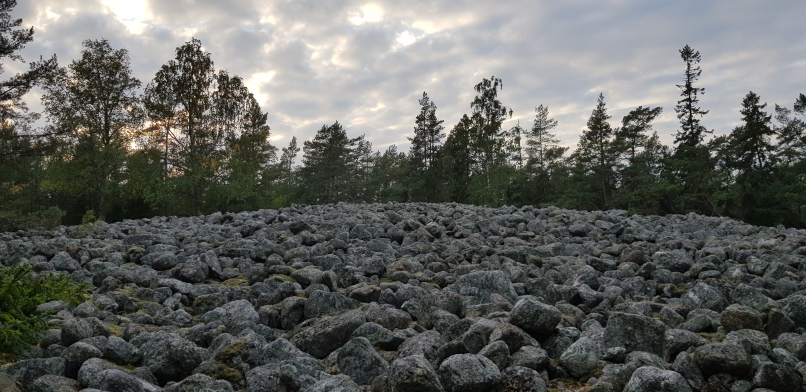

Explore the last Ice Age at the devil’s field of Kasnäs
At Kasnäs on Kemiö Island, a devil’s field unfolds. This site, once part of the ancient shoreline of the Litorina Sea dating back to around 11,000–6,000 BCE, features an ancient shingle beach encircled by colossal glacial erratics, naturally situated in the heart of a forest.
Rumavaara and devil’s field in Pudasjärvi
Rumavaara, situated in the Oulu province in Pudasjärvi municipality, is renowned for its captivating nature. To reach Rumavaara, one must traverse the infamous devil’s field first.
Superstitions surrounding Bronze Age heap tombs
Bronze Age tombs are also known as heap tombs, röykkiöhauta in Finnish. Built on elevated hills with commanding views of the sea, Bronze Age mounds often served as burial sites. This burial practice, imported to coastal areas of Finland from other parts of Europe, involved honoring notable individuals by interring them in monumental heap tombs atop these high hills. While many heap tombs served as burial sites, not all had this purpose; some may have functioned as landmarks and ritual spaces. Originally, when the knowledge of their actual contents was lost to history, superstitious Finns came to believe that goblins dwelled within these mounds.
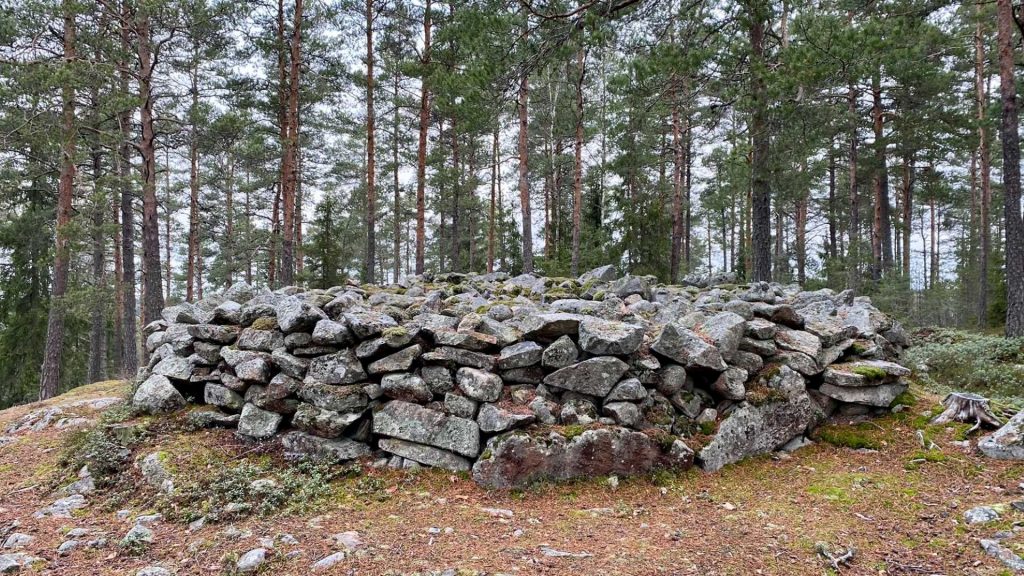

Penimäki heap tombs in Paimio date back to Bronze Age
Penimäki heap tombs are located in between highway 1 and old highway between Turku and Salo. Penimäen vare is a massive mound that really reminds me of a stove in sauna. In Finnish folklore, the heap tombs were referred as giant’s stoves (=hiidenkiuas) because they were believed to be homes of goblins (=hiisi).
Ancient tombs are the crowns of Viitankruunu hills in Salo
Viitankruunu is an ancient tomb site located in Salo in Southwest Finland. Viitanmäki hosts three Bronze Age burial mounds on top of a hill overlooking Halikonlahti bay.
Lehtisaari heap tombs are a historical gem in Helsinki
While many recognize Lehtisaari Island as one of the numerous islands bordering the Espoo and Helsinki archipelago in the West, what remains unknown to most is the presence of several Bronze Age heap tombs on the island.
Kasakallio hill is home to ancient tombs and guard lights
Kasakallio, situated in the Östersundom district of Helsinki, stands as a prominent hilltop offering views of the Baltic Sea to the east. This strategic location is also home to a Bronze Age tomb.
Hanikka nature trail has ancient tombs, glacial erratics, and views by the sea
Winding through the southwestern corner of the capital area, precisely in Soukka, Espoo, the exceptional Hanikka nature trail meanders by two narrows and one bay area. This diverse trail boasts extensive duckboards, enchanting alder-tree and pine-tree forests, Bronze Age burial mounds, and excellent spots for bird-watching. Atop Sundsberget hill, two ancient tombs adorned with sizable rock chunks add to the trail’s allure.
Other sites with fascinating connections to Finnish mythology
Many nature trails boast peculiar boulders and rock formations, each carrying folk stories passed down through generations. Here are few examples.
Hyypiö trail in Liesjärvi National Park hosts Mörri’s hideaway
Hyypiö trail is a short and versatile nature trail in Liesjärvi National Park, which is one of the oldest national parks in Finland. Along this nature trail, you can encounter Mörri’s hideaway. In Finnish mythology, creatures like Mörri-Möykky, commonly associated with death or evil spirits, were not perceived as malevolent. Folklore portrays these goblins as uncomplicated beings coexisting with humans, often avoiding daylight.
Tepasto nature trail in Kittilä is a home for gnomes
Tepasto village in north of Kittilä has a peaceful nature trail called Perhejärvi. Along the nature trail you can find a place called Gnomes’ rocks (Maahisten kalliot in Finnish). Gnomes in the Finnish mythology are small, human-like creatures, who live underground in their own world and usually cannot be seen. There is a fascinating story connected to the gnomes in this location.
Odd giant’s sarcophagus in Tammela was a sacrificial altar
Giant’s sarcophagus, jättiläisen hauta, is a large retangle boulder in Tammela in Tavastia Proper region. Concealed within the forest, this enigmatic boulder resembles a colossal coffin. A knock on its side produces a hollow sound. What tale does this Iron Age giant’s sarcophagus hold?
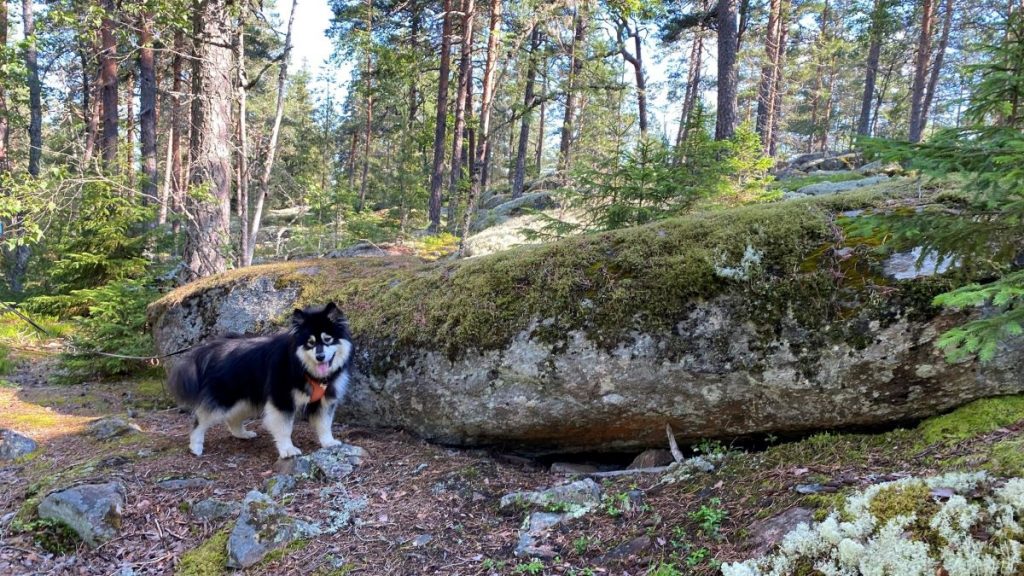

The deep respect for nature embedded in Finnish mythology has greatly influenced the way Finnish people think and live. Finland’s dedication to protecting the environment, adopting sustainable lifestyles, and allowing freedom to explore nature all show a shared awareness of the essential importance of the natural world.
What is the coolest thing about Finnish mythology you have learned? Do you have favourite sacred sites in Finland?
